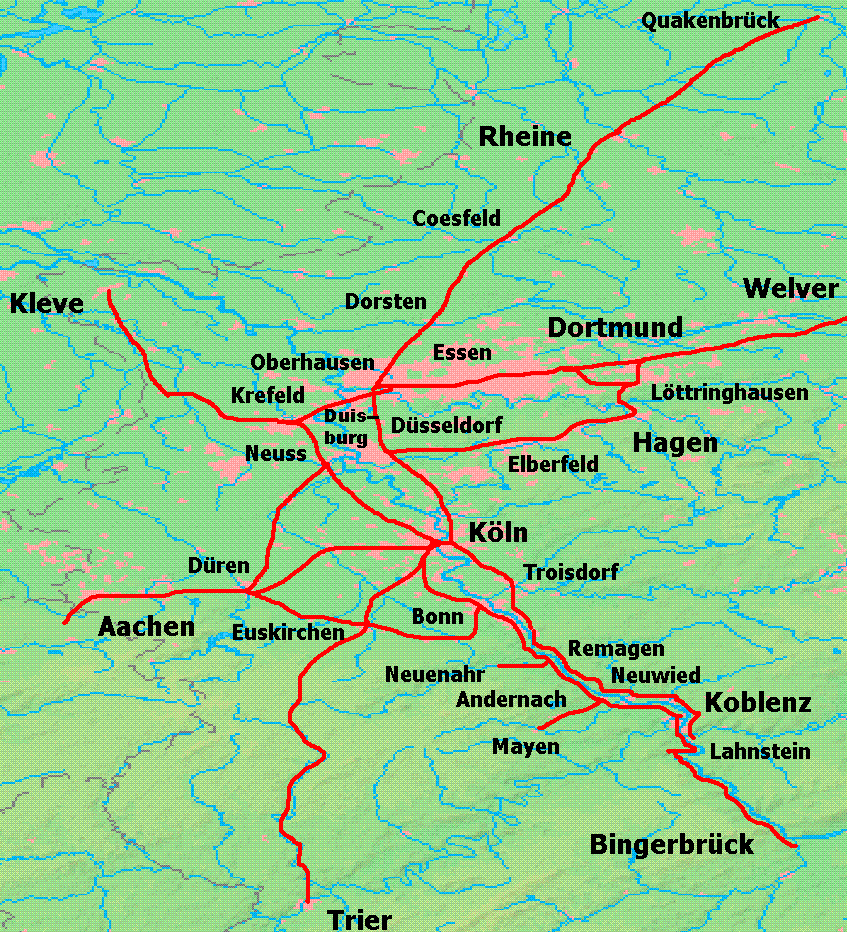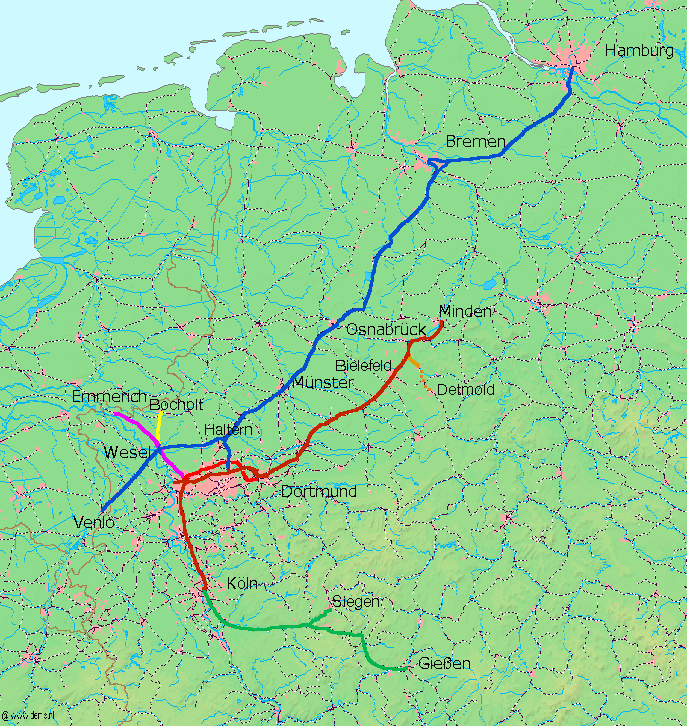|
S2 (Rhine-Ruhr S-Bahn)
Line S2 is a S-Bahn line in the Rhein-Ruhr network. It starts in Dortmund Hauptbahnhof and runs westerly. During weekdays one service per hour runs each to Essen Hauptbahnhof and Recklinghausen Hauptbahnhof using Stadler FLIRT 3XL units. Line S2 runs over lines built by various railway companies: * from Dortmund Hauptbahnhof to Dortmund-Dorstfeld over the Witten/Dortmund–Oberhausen/Duisburg railway, opened by the Bergisch-Märkische Railway Company in 1862 * from Dortmund-Dorstfeld to Dortmund-Mengede over the Welver–Sterkrade railway, built by the Royal Westphalian Railway Company on 1 September 1878. *from Dortmund-Mengede to Gelsenkirchen Hauptbahnhof via Herne station over the Duisburg–Dortmund Railway opened by the Cologne-Minden Railway Company in 1847, *from Gelsenkirchen to Essen over the Essen–Gelsenkirchen railway, opened from Gelsenkirchen to Essen-Kray Nord by the Rhenish Railway Company in 1872 and from Essen-Kray Nord to Essen Hauptbahnhof by the Prussi ... [...More Info...] [...Related Items...] OR: [Wikipedia] [Google] [Baidu] |
Dortmund-Dorstfeld Station
Dortmund-Dorstfeld is an S-Bahn station in Dortmund in the German state of North Rhine-Westphalia. It the second most important S-Bahn node in the city after Dortmund Hauptbahnhof. It has four above-ground tracks, which are accessible via two island platforms and two underground tracks that are accessible via side platforms. The station is classified as a category 3 station. It is served by Rhine-Ruhr S-Bahn lines S1, S2 and S4. Significance The station is served by three lines of the Rhine-Ruhr S-Bahn, the S1 from Dortmund to Solingen, the S2 from Dortmund to Herne (and continuing to Recklinghausen or Essen) and the S4 from Dortmund-Lütgendortmund to Unna. All three lines are operated by DB Regio NRW and run at 30-minute intervals (15-minute intervals in the peak on the section through Dortmund-Dorstfeld). The station is a railway junction and is particularly important because line S4 uses an historic route (the Welver–Sterkrade railway, which was built by the Royal We ... [...More Info...] [...Related Items...] OR: [Wikipedia] [Google] [Baidu] |
Gelsenkirchen Hauptbahnhof
Gelsenkirchen Hauptbahnhof is a railway station in the German city of Gelsenkirchen. It connects the city to the regional and long-distance rail service of Deutsche Bahn and other railway companies in Germany. History The Gelsenkirchen railway station was opened in 1847 with the Cologne-Minden railway. The station has since been rebuilt two times. The first time was in 1904, because the capacity of the old station was no longer sufficient. Since then the station has been a Hauptbahnhof. As part of this construction project, the tracks, which were located at ground level at the time, were raised. This allowed for traffic to Bochum could happen freely pass through. The second new development was carried out from 1982 to 1983. In preparations for the 2006 FIFA World Cup the station underwent extensive renovations. On 4 August 1914, English civilian Henry Hadley was fatally shot by a German officer while their train was standing at the station. Dying the next day, shortly after war ... [...More Info...] [...Related Items...] OR: [Wikipedia] [Google] [Baidu] |
S2 (Rhine-Ruhr S-Bahn)
Line S2 is a S-Bahn line in the Rhein-Ruhr network. It starts in Dortmund Hauptbahnhof and runs westerly. During weekdays one service per hour runs each to Essen Hauptbahnhof and Recklinghausen Hauptbahnhof using Stadler FLIRT 3XL units. Line S2 runs over lines built by various railway companies: * from Dortmund Hauptbahnhof to Dortmund-Dorstfeld over the Witten/Dortmund–Oberhausen/Duisburg railway, opened by the Bergisch-Märkische Railway Company in 1862 * from Dortmund-Dorstfeld to Dortmund-Mengede over the Welver–Sterkrade railway, built by the Royal Westphalian Railway Company on 1 September 1878. *from Dortmund-Mengede to Gelsenkirchen Hauptbahnhof via Herne station over the Duisburg–Dortmund Railway opened by the Cologne-Minden Railway Company in 1847, *from Gelsenkirchen to Essen over the Essen–Gelsenkirchen railway, opened from Gelsenkirchen to Essen-Kray Nord by the Rhenish Railway Company in 1872 and from Essen-Kray Nord to Essen Hauptbahnhof by the Prussi ... [...More Info...] [...Related Items...] OR: [Wikipedia] [Google] [Baidu] |
Wanne-Eickel–Hamburg Railway
The Wanne-Eickel–Hamburg railway is the shortest railway link between the Metropole Ruhr and the Hamburg Metropolitan Region and hence one of the most important railway lines in northwest Germany. The Route runs over the cities Münster (Westfalen), Osnabrück and Bremen. It was built between 1870 and 1874 by the Cologne-Minden Railway Company (CME) based in Wanne-Eickel, and branched off their main (Cologne-)Deutz–Minden route as part of the Hamburg-Venlo railway. Today it is an electrified main line which has a minimum of two tracks throughout. Parts of the route are equipped with '' Linienzugbeeinflussung'' train control which enables speeds of up to 200 km/h to be attained. Due to its constant use by goods and passenger trains rolling along the line, day and night, it has been given the nickname ''Rollbahn'' ("Rolling Line"). History The railway was built by the Cologne-Minden Railway Company (CME) under contract to the Prussian state as the eastern element of a ... [...More Info...] [...Related Items...] OR: [Wikipedia] [Google] [Baidu] |
Deutsche Reichsbahn
The ''Deutsche Reichsbahn'', also known as the German National Railway, the German State Railway, German Reich Railway, and the German Imperial Railway, was the German national railway system created after the end of World War I from the regional railways of the individual states of the German Empire. The ''Deutsche Reichsbahn'' has been described as "the largest enterprise in the capitalist world in the years between 1920 and 1932"; nevertheless its importance "arises primarily from the fact that the Reichsbahn was at the center of events in a period of great turmoil in German history". Overview The company was founded on 1 April 1920 as the ("German Imperial Railways") when the Weimar Republic, which still used the nation-state term of the previous monarchy, (German Reich, hence the usage of the in the name of the railway; the monarchical term was ), took national control of the German railways, which had previously been run by the German states. In 1924 it was reorganise ... [...More Info...] [...Related Items...] OR: [Wikipedia] [Google] [Baidu] |
Prussian State Railways
The term Prussian state railways (German: ''Preußische Staatseisenbahnen'') encompasses those railway organisations that were owned or managed by the State of Prussia. The words "state railways" are not capitalized because Prussia did not have an independent railway administration; rather the individual railway organisations were under the control of the Ministry for Trade and Commerce or its later offshoot, the Ministry for Public Works. The official name of the Prussian rail network was ''Königlich Preußische Staatseisenbahnen'' (K.P.St.E., "Royal Prussian State Railways") until 1896, ''Königlich Preußische und Großherzoglich Hessische Staatseisenbahn'' (K.P.u.G.H.St.E., " Royal Prussian and Grand-Ducal Hessian State Railways") until the end of the First World War, and ''Preußische Staatsbahn'' (P.St.B., "Prussian State Railway") until its nationalization in 1920. A common mistake is the use of the abbreviation K.P.E.V. in supposed reference to a mythical "Royal Prussian ... [...More Info...] [...Related Items...] OR: [Wikipedia] [Google] [Baidu] |
Rhenish Railway Company
The Rhenish Railway Company (German language, German: ''Rheinische Eisenbahn-Gesellschaft'', RhE) was along with the Cologne-Minden Railway Company (CME) and the Bergisch-Märkische Railway Company (BME) one of the railway companies that in the mid-19th century built the first railways in the Ruhr and large parts of today's North Rhine-Westphalia. Foundation The industrialists of the Rhineland and the Bergisches Land, then part of Prussia, sought to avoid paying the high tolls for using the Rhine imposed by the Netherlands and very early in its development, saw the possibility of the new means of transport, the railway. As early as the 1830s committees were established the cities of the Rhineland to promote proposals for building railways. Some of the members of the Cologne committee under David Hansemann (1790–1864)—a merchant and banker from Aachen—and the Aachen Committee favoured a railway line through Belgium to the seaport of Antwerp via Liege. Belgium, which had bee ... [...More Info...] [...Related Items...] OR: [Wikipedia] [Google] [Baidu] |
Essen-Kray Nord Station
Essen-Kray Nord is a railway station on the Essen–Gelsenkirchen railway situated in Essen in western Germany. It is classified by Deutsche Bahn as a category 6 station. It is served by Rhine-Ruhr S-Bahn line S 2 and by bus routes 144 (Steele – Annental – Stadtwaldplatz), 146 (Leithe Wackenberg + Essen Hbf – Stadtwald – Heisingen), 147 (Porscheplatz – Haarzopf Erbach + Grimbergstr), 170 (Steele + Schonnebeck – Katernberg – Altenessen – Borbeck) and 194 (Gelsenkirchen Hbf Gelsenkirchen Hauptbahnhof is a railway station in the German city of Gelsenkirchen. It connects the city to the regional and long-distance rail service of Deutsche Bahn and other railway companies in Germany. History The Gelsenkirchen railwa ... + Steele – Stadtwald – Haarzopf) operated by ''Ruhrbahn''. References S2 (Rhine-Ruhr S-Bahn) Rhine-Ruhr S-Bahn stations Kray Nord Railway stations in Germany opened in 1872 {{NorthRhineWestphalia-railstation-stub ... [...More Info...] [...Related Items...] OR: [Wikipedia] [Google] [Baidu] |
Essen–Gelsenkirchen Railway
The Gelsenkirchen Essen railway is a double-track, electrified main line railway in the central Ruhr area of the German state of North Rhine-Westphalia. It runs from Essen Hauptbahnhof via Essen-Kray Nord to Gelsenkirchen Hauptbahnhof. History Between 1866 and 1874 the Rhenish Railway Company (german: Rheinische Eisenbahn-Gesellschaft, RhE) built its own Ruhr line from Osterath on the Lower Left Rhine Railway to Dortmund RhE station, in competition with the Witten/Dortmund–Oberhausen/Duisburg railway built by the Bergisch-Märkische Railway Company (''Bergisch-Märkische Eisenbahn-Gesellschaft'', BME) between 1860 and 1862 and the Duisburg–Dortmund railway completed by the Cologne-Minden Railway Company (''Cöln-Mindener Eisenbahn-Gesellschaft'', CME) in 1848 and which ran a little further north. The Rhenish line was opened to ''Wattenscheid RhE'' (later called ''Gelsenkirchen-Wattenscheid'') station in 1868 and completed to ''Dortmund RhE'' six years later. During construc ... [...More Info...] [...Related Items...] OR: [Wikipedia] [Google] [Baidu] |
Cologne-Minden Railway Company
The Cologne-Minden Railway Company (German, old spelling: ''Cöln-Mindener Eisenbahn-Gesellschaft'', ''CME'') was along with the Bergisch-Märkische Railway Company and the Rhenish Railway Company one of the railway companies that in the mid-19th century built the first railways in the Ruhr and large parts of today's North Rhine-Westphalia. Founding The founding of the Cologne-Minden Railway Company in 1843 in Cologne ended a long struggle for a railway line between the Rhineland and the German North Sea ports, as well as the Prussian capital of Berlin. From the 1830s several railway committees in the cities of Düsseldorf, Cologne and Aachen attempted to find a solution with each other and the Prussian government. The focus of all these efforts was to avoid the Dutch duties on trade on the Rhine, which significantly increased the cost of import and export of goods via the Rhine. Some of the Cologne committee members under David Hansemann (1790–1864)—a merchant and banker fr ... [...More Info...] [...Related Items...] OR: [Wikipedia] [Google] [Baidu] |







